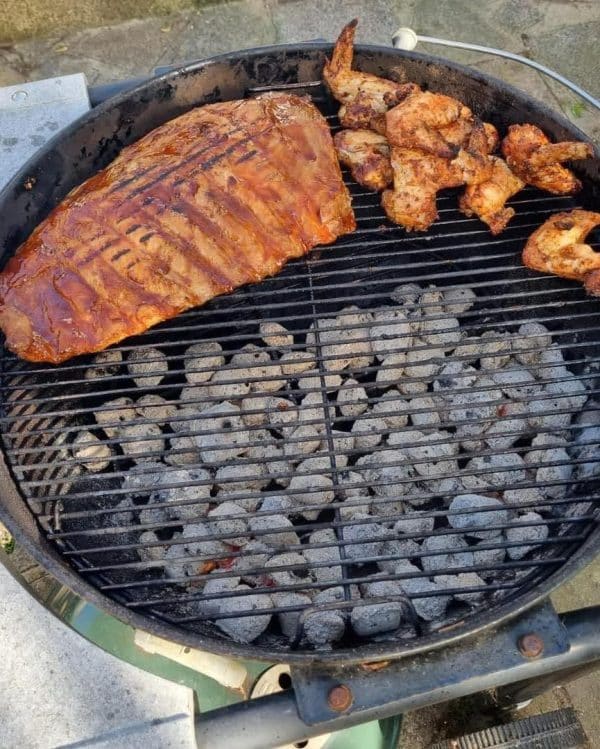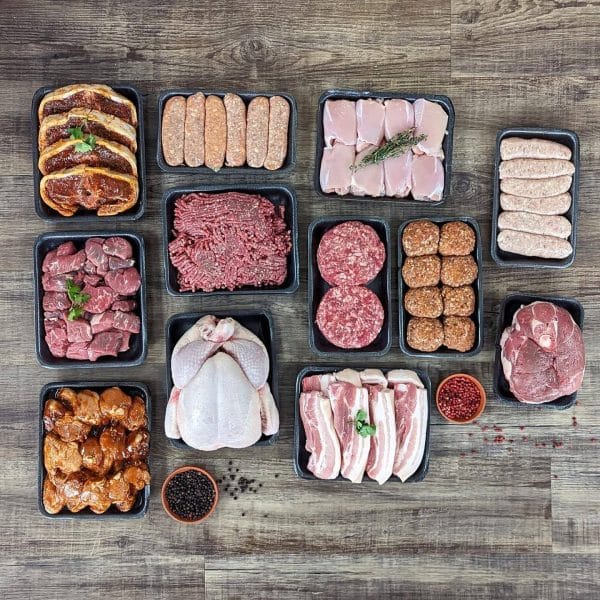Best Techniques for Your Kettle BBQ
Brief Overview
Using a kettle BBQ is a timeless method for outdoor cooking, offering versatility and efficiency. The kettle design allows for both direct and indirect grilling, making it suitable for a variety of recipes. Its dome-shaped lid ensures even heat distribution, enhancing the flavour and tenderness of the food. Whether you’re grilling burgers, smoking a brisket, or baking pizza, a kettle BBQ can handle it all.
Importance
Mastering kettle BBQ techniques can significantly elevate your cooking results. Understanding how to control the temperature, manage coals, and utilise different types of fuel like charcoal briquettes, wood logs, and hardwood logs, enables you to achieve consistent, high-quality results. Proper techniques can reduce cooking time, improve safety, and enhance the flavour profile of your food, making each barbecue session a success.
Choosing the Right Fuel for Your Fire
Types
Lumpwood Charcoal
Lumpwood charcoal is made by burning wood in the absence of oxygen, leaving behind pure carbon. It’s known for burning hotter and faster than other fuels, making it ideal for searing and grilling.
Charcoal Briquettes
Charcoal briquettes are made from compressed sawdust and other wood by-products, often with additives to help them burn consistently. They provide a steady, even heat and are great for long, slow cooks.
Firewood Logs
Wood logs are unprocessed, natural wood pieces that provide a traditional, smoky flavour. They are perfect for smoking and grilling, imparting unique aromas and tastes to the food.
Hardwood Logs
Hardwood logs, such as premium hardwood such as oak and olive, burn longer and hotter than softwoods. They are excellent for maintaining a steady temperature over extended periods, making them ideal for smoking and slow cooking.
Shop section
Pros and Cons
Lumpwood Charcoal
- Pros: Burns hotter, lights quickly, no additives.
- Cons: Burns quickly, inconsistent sizes can affect heat control.
Charcoal Briquettes
- Pros: Consistent burn, steady heat, longer cooking times.
- Cons: Contains natural additives but produces more ash.
Firewood logs
- Pros: Natural, imparts strong smoky flavour, long burn time.
- Cons: Requires more effort to light, less consistent heat.
Hardwood Logs
- Pros: Long burn time, steady heat, intense smoke flavour.
- Cons: Harder to ignite, may require more storage space.

Setting Up the Kettle BBQ
Basic Setup
Step-by-Step Guide to Assembling and Preparing the BBQ:
- Unpack the Kettle BBQ: Lay out all the components and tools.
- Assemble the Base: Attach the legs to the base and secure them with the provided screws.
- Install the Cooking Grate: Place the charcoal grate at the bottom of the kettle.
- Add the Charcoal: Spread a layer of coals or charcoal briquets evenly on the grate. If you have charcoal baskets, place them flat side together with a firelighter in between.
- Set Up the Lid: Attach the lid handle and thermometer (if available).
- Preheat the Grill: Light the coals and let the BBQ heat up for about 15-20 minutes before cooking.
Tools Needed
- Charcoal Chimney Starter: For lighting charcoal quickly and evenly.
- Tongs: One dedicated to handling charcoal and another for handling food. Depending on the meat you are preparing, a tong or a meat hook works well.
- Grill Brush: For cleaning the grates.
- Heat-resistant Gloves: For safety while handling hot components.
- Thermometer: To monitor grill temperature.
- Ash Can: For disposing of ash safely.
The Snake Briquette Method
Introduction
The snake briquette method is a popular technique for maintaining a consistent, low-and-slow cooking temperature on a kettle BBQ. It involves arranging the charcoal briquettes in a specific way to create a slow-burning “snake” that gradually ignites over several hours. This method is particularly favoured for smoking meats as it provides a steady heat source and prolonged cooking time without the need for frequent refuelling.
Step-by-Step Guide
Preparation
- Arrange the Charcoal Briquettes: Start by placing two rows of charcoal briquettes around the edge of the grill in a half-circle or snake formation. Place a second layer of briquets on top of the first row.
- Add Wood Chips: For added flavour, place wood chips on top of the snake at intervals.
Lighting the Charcoal
- Ignite the Snake: Light one end of the snake using a few briquettes from a charcoal chimney or firelighters. Allow the lit briquettes to gradually ignite the others in the snake.
Managing the Temperature
- Control the Airflow: Adjust the vents on your kettle BBQ to control the airflow and maintain a consistent temperature. Opening the vents increases the temperature while closing them reduces it.
- Monitor with a Thermometer: Use a grill thermometer to keep an eye on the internal temperature, aiming for a steady 225°F to 250°F (107°C to 121°C) for low-and-slow cooking.
Cooking Time
- Duration: Depending on the length of your snake and the amount of charcoal used, the snake method can provide consistent heat for up to 8-12 hours. This makes it ideal for smoking larger cuts of meat such as brisket, pork shoulder, or ribs.

Direct Grilling
Description: Direct grilling involves placing food directly over the heat source, whether using wood, hardwood logs, briquettes, or lumpwood charcoal. This method is ideal for cooking smaller, tender cuts of meat that benefit from high heat and quick cooking times.
- Best For: Steaks, burgers, sausages, chicken breasts, and vegetables.
- How to Use: Spread an even layer of coals or briquettes across the grill grate, or use wood logs for a smoky flavour. Place the food directly over the heat and cook, turning as needed.
Indirect Grilling
Description: Indirect grilling involves placing the food away from the direct heat source, using either wood, hardwood logs, briquettes, or lumpwood charcoal to create a slower, more even cooking environment. This method is excellent for larger cuts of meat that require longer cooking times without burning.
- Benefits: Provides even heat distribution, reduces the risk of burning, and is ideal for slow-cooking and smoking.
- Best Practices: Arrange the coals or briquets on one side of the grill, or place wood logs on the edges, leaving an area without direct heat. Place a drip pan under the food to catch juices and prevent flare-ups. Maintain a steady temperature by adjusting the vents.
Wood chip shop section
Using Wood for Added Flavour
Popular Choices and Their Flavour Profiles:
- Oak Brandy: Infused with a hint of brandy, this wood provides a rich, robust smoky flavour with a subtle sweetness. It’s excellent for enhancing the taste of red meats, particularly steaks and roasts.
- Apple: Sweet and mild, applewood imparts a delicate fruity flavour, making it perfect for poultry and pork. Its gentle smokiness adds a pleasant aroma without overpowering the natural taste of the meat.
- Olive Wood: Known for its unique and slightly bitter flavour, olive wood offers a distinct Mediterranean touch. It’s ideal for fish, poultry, and lamb, adding a refined, earthy note to the dishes.
- Beech Wood: Beech wood produces a mild, nutty flavour that’s versatile and can be used with almost any type of meat. Its subtle smokiness is particularly good for sausages, ham, and other cured meats.
- Citrus Wood: With a light and tangy profile, citrus wood brings a refreshing, zesty flavour to the table. It’s best suited for poultry, seafood, and pork, adding a bright, aromatic smokiness that complements lighter meats.
- Whiskey Smoking: Wood soaked in whiskey or whiskey barrel chips provides a rich, complex flavour with notes of caramel and oak. This type of wood is perfect for beef, particularly brisket, as well as for game meats, adding depth and a touch of sweetness.
Soaking Wood Logs or Chips
How and Why to Soak Before Use:
- How: Submerge wood logs or chips in water for at least 30 minutes before using.
- Why: Soaking prevents wood from burning too quickly, ensuring a steady release of smoke for enhanced flavour.
Adding to the Kettle
Tips for Placing Wood Logs for Optimal Smoke:
- Placement: Place soaked wood logs or chips directly on the hot coals.
- Arrangement: For consistent smoke, scatter chips evenly or position logs near the edges of the charcoal for a slower burn.

Cleaning and Maintenance
Post-Cooking Tips
How to Clean the Kettle BBQ After Use:
- Before Cool Down: Scrape off any residue with a grill brush while the BBQ is still warm.
- Cool Down: Allow the BBQ to cool completely.
- Remove Ashes: Scoop out the cooled ash and dispose of it safely.
- Clean the Grates: Use a grill brush to scrub off any remaining residue on the grates.
- Wipe Down: Wipe the inside and outside of the kettle with a damp cloth to remove any grease or ash.
Regular Maintenance
Keeping Your BBQ in Top Condition:
- Inspect Regularly: Check for rust, cracks, or damage to the grill components.
- Oil the Grates: Apply a thin layer of oil to the grates to prevent rust and sticking.
- Store Properly: Keep the BBQ covered and in a dry place when not in use to protect it from the elements.
Expert Tips and Tricks
BBQ Masters’ Advice
- Chef John Smith: “Always preheat your kettle BBQ with the lid on to ensure even cooking temperatures.”
- Pitmaster Jane Doe: “Use a combination of wood logs and charcoal briquettes for the best flavour and consistent heat.”
- Grill Expert Mike Brown: “Invest in a quality thermometer to monitor both the grill and meat temperatures accurately.”
Common Mistakes to Avoid
- Overloading the Grill: Avoid placing too much food on the grill at once, as it can lower the temperature and result in uneven cooking. Instead, cook in batches if needed.
- Improper Vent Management: Mismanaging the vents can cause temperature fluctuations. Keep the top and bottom vents partially open to control the airflow and maintain a steady heat.
- Skipping Preheating: Not preheating the grill can lead to sticking and uneven cooking. Always allow the BBQ to preheat for 15-20 minutes.
Conclusion
Mastering kettle BBQ techniques involves choosing the right fuel, setting up properly, using methods like the snake briquette technique, and alternating between direct and indirect grilling. Additionally, using wood logs adds unique flavours, and maintaining your BBQ ensures longevity and optimal performance.
Discover the Perfect BBQ Experience with Kent Charcoal
At Kent Charcoal & Firewood Company, we pride ourselves on providing exceptional customer service and top-quality products. Whether you need charcoal briquettes, wood logs, or hardwood logs, we have you covered. Let us know what you require, no matter how big or small, and we will go the extra mile to make it happen. Contact our friendly and knowledgeable team with any questions or queries. Trust us to help you achieve the perfect BBQ experience.
Visit our website or call us today to place your order!